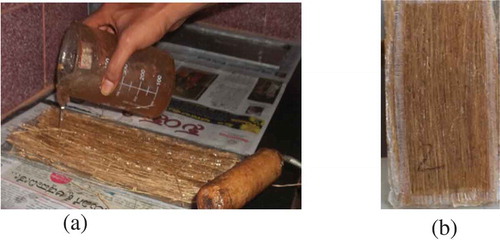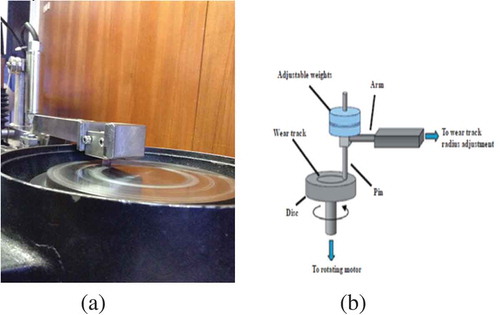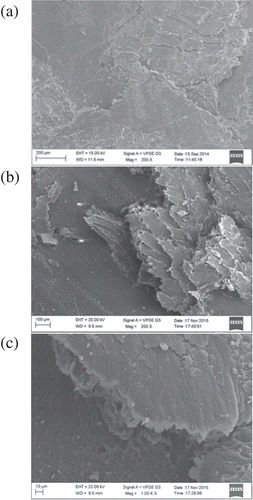 ?Mathematical formulae have been encoded as MathML and are displayed in this HTML version using MathJax in order to improve their display. Uncheck the box to turn MathJax off. This feature requires Javascript. Click on a formula to zoom.
?Mathematical formulae have been encoded as MathML and are displayed in this HTML version using MathJax in order to improve their display. Uncheck the box to turn MathJax off. This feature requires Javascript. Click on a formula to zoom.Abstract
Development of new materials in place of existing traditional metals and alloys to meet specific requirements is taking place worldwide. Natural fibre reinforced composites are being considered as one of the alternative materials which can find scope in indoor and low load bearing applications. The biodegradability and low density make them attractive, while inherent hydrophilic nature of the fibre is a challenge for the engineering applications. Surface modification to the fibres by chemical treatments makes them as an alternative reinforcement material in the field of composites. In the present work, Grewia Serrulata bast fibres were subjected to chemical treatments and stitched into unidirectional woven fabrics. Treated and untreated fibre reinforced laminates were fabricated by hand layup process. Sliding wear behaviour of the prepared specimens was studied as per ASTM G-99. Materials with relatively lower wear rate are preferred for the tribological applications. The study shows that acetylated Grewia Serrulata fibre reinforced and permanganate treated fibre reinforced polyester samples showed significant wear resistance compared to neat resin and untreated fibre reinforced specimens.
PUBLIC INTEREST STATEMENT
This original research article is about the fabrication of light weight and ecofriendly materials using naturally available plant fibres. The article sheds light on usage of bio-based forest produces in forming alternative materials for light load bearing applications. Safe disposal possibility of such materials at the end of their service life makes them convenient alternative materials where environmental concerns are getting serious attention worldwide. Further, thus fabricated materials were tested for any possible improvement in the anti-wear qualities. Comparative study of the wear of the material without natural fibers and natural fiber-based materials is reported.
1. Introduction
Until a few decades ago, the mankind was used to traditional engineering materials such as metals and alloys. The metals are single phase materials while the alloys are multiphase materials. Due to excessive costs involved in processing the metals and alloys and requirement of complicated equipments and machineries to form such materials, another class of material called composite was developed. This newly developed product is basically a two-phase material, containing a strength offering phase known as reinforcement and an encapsulating matrix which stabilizes the reinforcement phase. Specific requirements of modern materials can be met mostly by reinforcing the natural or synthetic fibres in polymeric resins. The prominent synthetic fibres used for reinforcement are glass, carbon, kevlar, graphite etc. A serious disadvantage of such synthetic fibres is that they are non-bio degradable. Environmental concerns over synthetic fibres has raised interest in the use of biodegradable plant and animal based natural fibres. Many researchers have identified plant based natural fibres such as jute, coir, flax, sisal, kenaf, hemp, bamboo etc. as an alternative reinforcement in the field of composite materials (Bledzki, Reihmane, & Gassan, Citation1996; Gassan & Bledzki, Citation1999; Hamdan, Bachtiar, & Sapuan, Citation2008; Herrera-Franco & Valadez-Gonzalez, Citation2005; Valadez-Gonzalez, Cervantes-Uca, Olayob, & Herrera-Franco, Citation1999). The main advantages of natural fibres over synthetic fibres are abundant availability, low cost, low density, comparable specific tensile properties, low abrasiveness, non-irritation to the skin, reduced energy consumption, renewability. Added advantage of biodegradability makes them an attractive alternative as reinforcement material (Bledzki et al., Citation1996; Herrera-Franco & Valadez-Gonzalez, Citation2005). However, in natural fibre reinforced polymer composites, bonding or adhesion between the hydrophilic fibres and the hydrophobic polymers is the major issue of concern during the fabrication process. This results in decrement of mechanical properties of the composites. It is therefore necessary to modify the fibre surface by employing suitable physical/chemical treatments to improve the bonding between the fibre and the matrix material. The tendency of natural fibres to absorb moisture can be minimized by chemical modification of natural fibres (Bledzki et al., Citation1996).
Wear is the removal of material from the surfaces when two bodies are having some type of relative motion. Wear results in loss of material from the surface of the relatively softer material. In commercial applications, it is desirable that the wear rate of the bodies in contact must be minimum so that the longevity of the system or equipment or the machinery is ensured. In two body sliding wear tests, the wear behaviour of the material under consideration, rubs against a relatively hard rotating standard metal disc. The results obtained from the test provides useful information about the friction and tribological behaviour of the material (Bahadur & Zheng, Citation1990).
In the present work, Grewia Serrulata natural fibres were reinforced with isophthalic polyester matrix material to synthesize the composites. Specimens were prepared with hand lay-up process. Two body sliding wear tests were performed on untreated, Permanganate treated, and acetylated natural Grewia Serrulata fibre reinforced polyester composites by varying normal load applied on the specimens and sliding speed between the specimen and the disc. A comparative study of the wear behaviour of the untreated and chemically treated fibre reinforced specimens was carried out. Scanning electron microscope images were used to understand the morphology of the worn specimens.
2. Materials and methods
Natural fibre based partially biodegradable composites were fabricated by reinforcing Grewia Serrulata bast fibres in polyester resin. The natural fibres were extracted by retting process from the branches of the Grewia Serrulata trees. To improve the compatibility between hydrophilic natural fibres and hydrophobic polymer resin system, the extracted fibres were initially subjected to alkali pre-treatment (with 5% Sodium Hydroxide-NaOH aqueous solution) and then followed by permanganate treatment and acetylation. Polyester, with a density of 1.089 g/cc, supplied by Ash polymers Bangalore, India was used as matrix material for preparing laminates.
2.1. Alkali pre-treatment
The raw fibres were subjected to 5% NaOH pre-treatment for an hour. Treated fibres were dried with hot air drier for the removal of moisture content (Herrera-Franco & Valadez-Gonzalez, Citation2005).
2.2. Acetylation treatment
The alkali pre-treated Grewia Serrulata fibres were immersed in acetylating solution. The temperature was maintained as 60°C and duration of the treatment was 1.5 h (Bledzki et al., Citation1996; Bledzki, Mamun, Lucka-Gabor, & Gutowski, Citation2008).
2.3. Potassium permanganate treatment
Another batch of alkali pre-treated fibres were soaked in 0.2% Potassium permanganate (KMnO4) solution for 3 min. Such treated fibres were flushed with distilled water and dried.
2.4. Fabrication of composite laminates
The unidirectional Grewia Serrulata fibre mats were weaved for the fabrication of the composite laminates. Conventional hand lay-up technique (Samivel & Ramesh Babu, Citation2013) was adopted for fabricating the specimens. Chemically modified fibres with 10% and 20% of volumefraction were stitched to form mats on rectangular metal frames. The matrix was prepared by adding 2% each of (by volume) cobalt solution and Methyl Ethyl Ketone Peroxide to the polyester resin in a beaker and stirring thoroughly (Mahesha, Satish Shenoy, Vijaya Kini, & Subrahmanya Bhat, Citation2016). The process of fabrication of the composites is shown in the Figure ). The laminates fabricated were cured at room temperature condition for 12 h and then separated from the mould. Figure ) shows the cured laminate.
3. Wear testing of specimens
3.1. Pin-on disc wear test
From the laminates prepared, specimens of pencil shape were cut out along the direction of the reinforcement fibres, using a jig saw for the wear analysis. Two body sliding wear tests were carried out on a pin-on disc-type wear and friction monitor as per ASTM G-99(Bahadur & Zheng, Citation1990), supplied by Magnum Engineers, Bangalore. This machine facilitates study of friction and wear characteristics in sliding contacts under desired conditions. Sliding occurs between the stationary pin (pencil-shaped specimen) and a carbon steel rotating disc. Normal load, rotational speed and wear track diameter can be varied to suit the test conditions. Tangential frictional force and wear are monitored with electronic sensors and recorded. These parameters are available as functions of load and speed.
The specimens were fixed to the sample holder and the wear machine with the desired settings started to spin the disc. The holder along with the pin shaped specimen was set at a track diameter of 80 mm. The two-body wear test set up and schematic representation of the set are shown in Figure and respectively. All the wear tests were conducted keeping the track diameter as constant.
During the test, the specimen was held stationary and disc was rotated at the desired rpm. Load was applied through a dead weight loading system to press the pin against the disc. All the specimens were tested for a sliding distance of 1800 m at three different sliding speeds, that is 1 m/s, 2 m/s and 3 m/s (Yallew, Kumar, & Singh, Citation2014). The weight loss in the specimen after each test was estimated by measuring the weight of the specimen before and after each test using an electronic balance with an accuracy of ± 0.001 mg. The following abbreviations are adapted for the specimens subjected to wear test.
UTGFRP- Untreated Grewia Serrulata Fibre Reinforced Polyester
PTGFRP- Permanganate treated Grewia Serrulata Fibre Reinforced Polyester
ATGFRP- Acetylated Grewia Serrulata Fibre Reinforced Polyester
4. Results and discussions
Wear is the loss of material due to relative motion between any two bodies. Determination of wear rate of the materials is necessary for understanding the tribological characteristics. Materials with relatively low wear rate are preferred for prolonged reliable operation of the systems in which they are used.
4.1. Wear rate analysis
Wear rate was estimated by measuring the weight loss of the specimen after each test. At the termination of each test, the specimen subjected to wear was cleaned with a soft cloth to ensure that no residues were left on the surface and then weighed. The weight loss of the specimen due to wear was estimated using equation 2;
where Δw is the weight loss in grams and w1 and w2 are the weight of the sample before and after the wear test in grams respectively.
The wear rate (W) was calculated by using the equation (3) (Deo & Acharya, Citation2010; Mohanty, Das, & Das, Citation2014):
where “W” is the wear rate in m3/m, “ρ” is the density of the composite, and “Sd” is the sliding distance in meter.
For characterization of the wear behaviour of the composite, the specific wear rate is used. Specific wear rate is defined as the volumeloss of the material per unit sliding distance and per unit applied load. The specific wear rate (Ko ) was calculated by using equation (4) (Deo & Acharya, Citation2010; Mohanty et al., Citation2014):
Where ‘K0 ’ is the specific wear rate in m3/N-m, “Δw” is the weight loss in grams, “sd” is the sliding distance in meter, and “L” is the applied load in N. The density of polyester is 1.089 g/cc and 1.2 g/cc for untreated fibre reinforced composites and 1.15 g/cc for the treated fibre reinforced composites.
The wear rate characteristics of various specimens tested at a normal load of 20 N are shown in Table .
Table 1. Sliding wear test results
Figure and shows the variation of wear rate with sliding speed at constant normal loads of 10 N and 20 N. For each sliding speed, the neat polyester specimens showed greater weight loss than the fibre reinforced composite specimens. The more pronounced wear rate of neat resin specimens was due to brittle nature of the specimen surface rubbing against the relatively hard rotating steel disc. However, considerable fall in wear rate was observed with reinforcement of fibres to the matrix material. The wear test results showed highest wear rate during mid level sliding speed of 2 m/s than at low and high sliding speeds of 1 m/s and 3 m/s respectively. Wear rate of chemically treated fibre reinforced composites found lesser than untreated fibre reinforced composites. Both permanganate-treated fibres and acetylated fibre reinforcement into polyester, decreased the composite wear rate considerably. This could be due to increase in the bonding strength between the natural fibre reinforcement phase and the polymeric matrix phase. Researchers have published that improvement in bonding at the interphase between the polymer matrix and the natural cellulosic fibre occurs due to treatments carried out on fibres(Bledzki et al., Citation1996, Citation2008; Gassan & Bledzki, Citation1999; Hamdan et al., Citation2008; Rokbi, Osmani, Imad, & Benseddiq, Citation2011).
4.2. SEM analysis
The SEM images of the worn out surfaces of the specimens are shown in Figure –. The wear on specimen surfaces includes micro-cracking, micro-cutting, and micro-ploughing mechanisms. The result analysis shows that the relative sliding speed between the specimen and the disc, and normal load acting on the specimen has significant effect on the wear rate. By the SEM analysis, it is evident that more furrows and cracks are seen in specimens prepared with neat resin (Figure )) than the specimens prepared with treated fibre reinforced composites. This is due to highly brittle nature of the neat polyester specimens. The reinforcement of treated fibres into the resin, tends to decrease the brittleness of the specimens. Similar conclusion was drawn by the other studies on sliding wear behaviour of polymer matrix composites (Bahadur & Zheng, Citation1990; Chand, Dwivedi, & Sharma, Citation2007). The enhanced bonding between the fibres and the matrix reduces the large furrows being formed due to ploughing like effect during the sliding wear test.
5. Conclusions
The following conclusions are drawn from the present work.
Thermoset resins such as polyester can be used as matrix material with Natural Grewia Serrulata as reinforcement to prepare partially bio degradable composite materials.
The Grewia Serrulata fibre reinforcement into polyester resin improves the wear resistance significantly.
Two-body wear test results showed natural fibre treatment with acetylation and permanganate solution significantly improves bonding strength at the fibre matrix interphase and hence improvement in wear resistance.
The normal load and sliding speed significantly affect the wear rate of the composite specimens.
Additional information
Funding
Notes on contributors
Satish Shenoy B
Shenoy B. Satish is the Professor in the Department of Aeronautical and Automobile Engineering, Manipal Institute of Technology, Manipal, India. He pursued PhD in Mechanical Engineering. His research areas are tribology, computational fluid dynamics, composite structures.
References
- Bahadur, S. , & Zheng, Y. (1990). Mechanical and tribological behavior of polyester reinforced with short glass fibres. Wear , 137, 251–266. doi:10.1016/0043-1648(90)90138-Z
- Bledzki, A. K. , Reihmane, S. , & Gassan, J. (1996). Properties and modification methods for vegetable fibres for natural fibre composites. Journal of Applied Polymer Science , 59, 1329–1336. doi:10.1002/(SICI)1097-4628(19960222)59:8<1329::AID-APP17>3.0.CO;2-0
- Bledzki, A. K. , Mamun, A. A. , Lucka-Gabor, M. , & Gutowski, V. S. (2008). The effects of acetylation on properties of flax fibre and its polypropylene composites. eXPRESS Polymer Letters , 2, 413–422. doi:10.3144/expresspolymlett.2008.50
- Chand, N. , Dwivedi, U. K. , & Sharma, M. K. (2007). Development and tribological behavior of UHMWPE filled epoxy gradient composites. Wear , 184–190. doi:10.1016/j.wear.2006.04.012
- Deo, C. , & Acharya, S. K. (2010). Effects of fibre content on abrasive wear of Lantana camara fibre reinforced polymer matrix composite. Indian Journal of Engineering and Material Sciences , 17, 219–223.
- Gassan, J. , & Bledzki, A. K. (1999). Possibilities for improving the mechanical properties of jute/epoxy composites by alkali treatment of fibres. Composites Science and Technology , 59, 1303–1309. doi:10.1016/S0266-3538(98)00169-9
- Hamdan, M. M. , Bachtiar, D. , & Sapuan, S. M. (2008). The effect of alkaline treatment on tensile properties of sugar palm fibre reinforced epoxy composites. Materials and Design , 29, 1285–1290. doi:10.1016/j.matdes.2007.09.006
- Herrera-Franco, P. J. , & Valadez-Gonzalez, A. (2005). A study of the mechanical properties of short natural-fibre reinforced composites. Composites: Part B , 36, 597–608. doi:10.1016/j.compositesb.2005.04.001
- Mahesha, G. T. , Satish Shenoy, B. , Vijaya Kini, M. , & Subrahmanya Bhat, K. (2016). Preparation of unidirectional Grewia serrulata reinforced polyester composites and evaluation of tensile and flexural properties. Journal of Natural Fibres , 13, 547–554. doi:10.1080/15440478.2015.1081575
- Mohanty, J. R. , Das, S. N. , & Das, H. C. (2014). Effect of fibre content on abrasive wear behavior of date palm leaf reinforced polyvinyl pyrrolidone composite. Hindawi Publishing Corporation ISRN Tribology , Article ID 453924.
- Rokbi, M. , Osmani, H. , Imad, A. , & Benseddiq, N. (2011). Effect of chemical treatment on flexure properties of natural fibre-reinforced polyester composite. Procedia Engineering , 10, 2092–2097. doi:10.1016/j.proeng.2011.04.346
- Samivel, P. , & Ramesh Babu, A. (2013). Mechanical behavior of stacking sequence in kenaf and banana fibre reinforced-polyester laminate. International Journal of Mechanical Engineering & Robotic Research , 2, 348–360.
- Valadez-Gonzalez, A. , Cervantes-Uca, J. M. , Olayob, R. , & Herrera-Franco, P. J. (1999). Effect of fibre surface treatment on the fibre–Matrix bond strength of natural fibre reinforced composites. Composites: Part B , 30, 309–320. doi:10.1016/S1359-8368(98)00054-7
- Yallew, T. B. , Kumar, P. , & Singh, I. (2014). Sliding wear properties of jute fabric reinforced polypropylene composites. Procedia Engineering , 97, 402–411. doi:10.1016/j.proeng.2014.12.264




